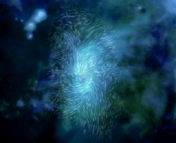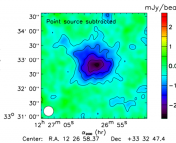Title: The Steward Observatory LEO Satellite Photometric Survey
Authors: Harrison Krantz, Eric C. Pearce, Adam Block
First Author’s Institution: University of Arizona Steward Observatory, USA
Status: Published in Publications of the Astronomical Society of the Pacific [open access]
As satellites proliferate in our low Earth orbit (LEO), astronomical surveys and students’ career trajectories are redirected from studying the mysteries of space to measuring and mitigating human effects. By the same token, members of the satellite industry have been encouraged to adjust satellite designs to mitigate damage to science. Today’s paper compares the fruits of such labors by analyzing the brightness of different satellite designs that have emerged over the last few years. The authors further propose two metrics – one for astronomers, another for industry– to assist further improvements and workarounds going forward.
To perform this study, the authors used the Steward Observatory SSA astrograph to take over 16,000 independent measurements of nearly 2800 individual Starlink and OneWeb satellites. As it was impossible to observe all visible satellites throughout the night, the authors also built a scheduler for their selected subset to view and observe differences in satellite product design. Perhaps the most unique aspect of this instrument is its portability– the Steward Observatory SSA astrograph exists in a trailer-mounted enclosure. The mobility of its enclosure allows the instrument to be relocated and different observing programs to be replicated without the need to move an entire observatory!
R&D in the FOV
The satellites in today’s paper span previous versions of Starlink and the current OneWeb structure (Figure 1). Due to feedback from the astronomical community concerning their brightness, Starlink has attempted several Research and Development (R&D) iterations for darker bodies. Because SpaceX launches satellites every 1 to 10 days, they recently launched adjusted prototypes, which astronomers can monitor to track how those changes affect observations.
In fact, as the paper reports, by the end of 2022, 3,460 out of 12,000 expected Starlink satellites had been launched into orbit; an extended satellite “constellation” may include as many as 42,000. The original Starlink fuselages have a configuration that, when closed, resemble a shark fin, and when open resemble a book, changing their solar reflectivity. Based on feedback from the astronomical community, the white material used on the nadir-facing (the opposite of zenith) antennae were made darker in the Starlink v1.0 DarkSat prototype– a single prototype satellite launched in 2020 January.
Rather than just trying darker fuselages, Starlink added a visor to attempt to shield reflected light from the sun, which debuted in the Starlink v1.0 VisorSat series, launched in 2020 May, also observed in this study. Due to the success of this prototype, all satellites launched from 2020 August to 2021 May utilize this design.
Another design change by Starlink appeared in the Starlink v1.5 version, which were launched 2021 June to 2022 December, featuring mirror stickers covering the nadir-facing phased array antennae, intended to reflect light back into space.
OneWeb satellites, on the other hand, have a “box-wing” style, and as of the end of 2022, there are 500 of 648 total satellites in orbit; with the potential to extend the constellation to more than 6,000. To date, they have not experimented with their design in a manner similar to Starlink.
Today’s authors determined that a useful metric for satellite operators is the albedo of the satellite, or its reflective quality. Astronomers may be familiar with this concept in the context of the moon, and the way it reflects sunlight and interferes with other astrophysical observations by increasing sky brightness.
The various generations of Starlink satellite design, as remarked upon by the authors, did reduce the effective albedo of the satellites in certain geometries, but not all. In fact, reflected light was reduced by more than 50% as measured with the effective albedo. However, this impressive percentage amounts to a difference of only 0.5–1.0 visual magnitudes, less than the difference between Vega and Sirius. For example, both versions with visors (Starlink v1.0 VisorSat) and the mirror stickers (Starlink v1.5) still typically appear as bright as 5th magnitude, a marked 2 mag brighter than the 7th magnitude threshold called for by the IAU CPS (an international hub for science and technology to collaborate).
The authors remark that reducing the quantity of reflected light by an additional 84% will be a significant engineering challenge. This may perhaps not be an undaunting task for Starlink, as they have historically proven to have their sights set on an ambitious future, as indicated by their preemptive declaration of Starlink use on Mars signed by every Starlink customer in the Terms of Service.
Permanent Shooting Stars
If you’re lucky enough to have made a wish on a shooting star, you probably remember the flash that caught your eye, which faded as quickly as it came. Satellites, too, change in brightness over their paths, but do not completely fade away like a shooting star. In general, LEO Satellites sail through space with varying velocities, traversing the entire sky in 10–20 minutes at a time. The timing and duration of the satellite’s increase in brightness has everything to do with the angle it forms between the sun and the observer, as well as its own geometry of reflecting parts on board.
Today’s authors took careful note to study where in the sky produced the most offending satellite-solar angles (Figure 2). Shockingly, the satellites did not appear brightest at zenith, where light would travel through less of the atmosphere. Instead, satellites were typically brightest at mid-elevations opposite the sun. The authors remark that some adjustments, such as physical visors on the satellites themselves to block light (Starlink v1.0 VisorSats; Figure 2), were not effective and shone brightly on regions of the sky opposite the sun.
Historically, measurements of satellites, such as those in Figure 2 and Figure 3, have been taken in terms of magnitude as an intuitive way for astronomers to compare to stellar brightness and how much brighter satellites appear than the heavenly bodies they are attempting to measure. However, much like a shooting star, the satellites change brightnesses in time along the observer’s line of sight.
Therefore, the authors calculated an additional feature, the “photon flux per arcsecond,” of the satellite trail, as seen through a fiducial 1m telescope (Figure 4), as all Starlink and OneWeb satellites will easily be seen by a 1m-class telescope. The greatest strength of using photon flux, as opposed to magnitude, is that it takes into account how quickly a satellite appears to be moving across the sky, which will manifest in the telescope as a change in brightness. For example, satellites will appear to move through zenith much faster than near the horizon, so they will appear much brighter for the same exposure time if they are near the horizon.
The authors further note that even if the delicate sensors used to measure faint, distant, cutting edge science are not saturated by the satellite trails themselves, the Poissonnian photon noise caused by the extra light may be large enough to completely obscure an overlapping, faint science target.
Blinded by the Lights
Mitigating the impacts of satellite light pollution, the authors explain, will require significant efforts from both academia and industry. New software tools and image processing methods will be required of astronomers. In order to continue uncovering the universe’s secrets and sparking curiosity for what lies beyond our atmospheric veil, strategic scheduling will be required of telescope operators to catch a chance around glinting fuselages, in addition to developing faster shutters that may block some additional light. Even on the level of funding, the authors mention that new observing programs will need to consider the impacts and risks posed by satellite interference when planning methodology and submitting proposals.
The authors are hopeful that the satellite operators themselves can use the effective albedo sky-plots to understand the geometries where their satellites are reflecting more light and use this information to evaluate their satellite design and identify opportunities to modify the design to reduce apparent brightness.
As per the proceedings of the SATCON1 workshop, the authors reiterate, no single solution will entirely mitigate all the impacts, nor is any single group responsible for producing all the solutions themselves. A co-existence in low earth orbit, for science and for industry, will require much meeting in the middle.
Astrobite edited by Janette Suherli
Featured image credit: Kees Scherer and from the Leader-Telegram Astronomy Update from the Chippewa Valley Astronomical Society; edited by the Astrobite author.




